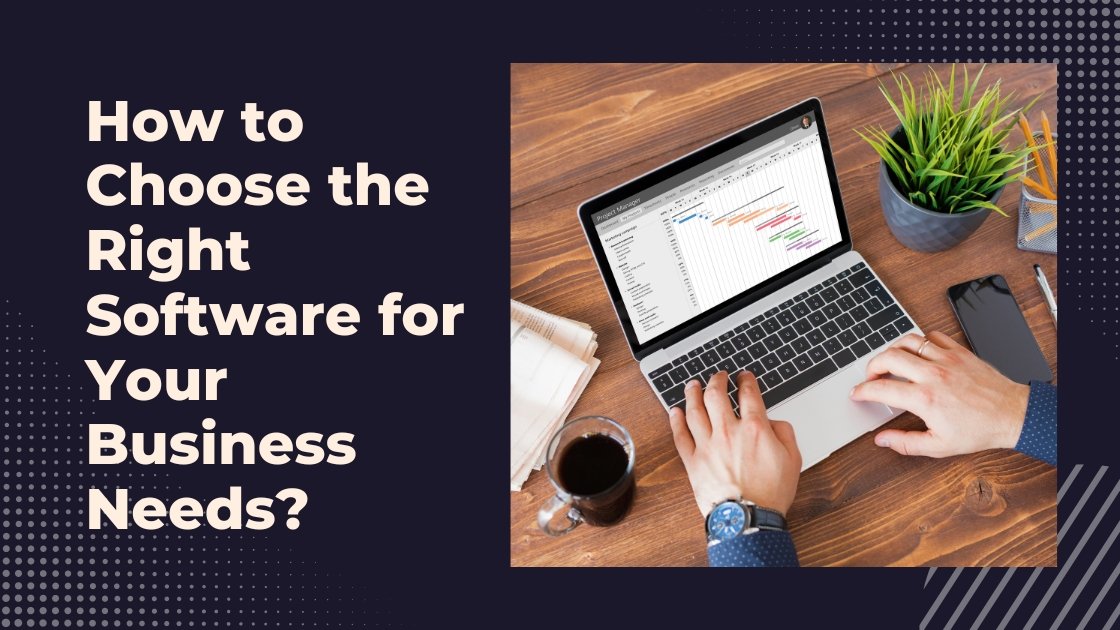Choosing the right software for your business can feel like a daunting task, but it’s one of the most important decisions you’ll make. The right software can streamline operations, enhance productivity, and ultimately help your business grow. With countless options available—from project management tools to customer relationship management systems—how do you decide what’s best for you? Let’s break it down step by step, making it as simple and straightforward as possible.
Understand Your Needs First
Before you even start browsing software options, take a moment to reflect on your business’s specific needs. Start by asking yourself some essential questions:
- What challenges are we currently facing? Are there specific areas where processes seem to get stuck or confused?
- What are our goals? Do you want to improve customer service, manage finances better, or streamline communication within your team?
- How do our current tools fall short? Are you still using spreadsheets for tracking, or is your team struggling to stay organized?
By clearly understanding your needs, you’ll be in a better position to find software that addresses those pain points effectively. This foundational step is crucial because it will guide your entire search process.
Types of Software You Might Consider
With a clear understanding of your needs, it’s time to explore the different types of software available. Here are some common categories to consider:
- ERP (Enterprise Resource Planning): This type of software, like Odoo, helps you manage various business functions in one place. It integrates everything from inventory management to accounting, making it ideal for businesses that want to streamline operations across departments. Imagine having all your data and tools in a single dashboard—no more switching between different programs!
- CRM (Customer Relationship Management): If your focus is on building strong customer relationships, CRM software like Salesforce or Zoho CRM can help you track customer interactions, manage leads, and enhance your marketing efforts. A good CRM can help ensure that you never miss an opportunity to connect with a potential client or follow up with an existing one.
- Project Management Tools: For keeping your projects on track, tools like Trello or Asana are fantastic options. They help you organize tasks, set deadlines, and collaborate with your team. You can easily visualize who’s doing what and when, which can lead to improved accountability and efficiency.
- Accounting Software: Managing finances is critical for any business. Software like QuickBooks can help you keep track of expenses, invoices, and payroll—all in one place. A good accounting tool will save you time and reduce the risk of errors in your financial reporting.
When exploring these options, consider which categories are most relevant to your team’s daily operations. This targeted approach will save you time and energy in the long run.
What Features to Look For
As you start evaluating software options, focus on key features that matter most to your business. Here’s what to keep an eye on:
- User-Friendliness: The software should be easy to navigate. If your team struggles to use it, productivity will take a hit. Look for solutions with intuitive interfaces that don’t require extensive training.
- Integration: The software should work well with the other tools you already use. For example, if you’re using email marketing software, choose a CRM that integrates seamlessly with it. This will help you avoid data silos and streamline workflows.
- Scalability: Choose software that can grow with your business. You want a solution that can adapt as your needs change, whether you’re adding new users, features, or locations.
- Customization: Look for options that allow you to tailor the software to fit your specific workflows. This way, you can modify it to match your business processes rather than changing how you work to fit the software.
- Security: If you handle sensitive customer data, make sure the software has strong security measures in place to protect that information. Look for features like data encryption and user authentication.
Budgeting Is Key
Now, let’s talk about money—budgeting is an essential part of selecting software. Here are some important factors to consider:
- One-Time Purchase vs. Subscription: Some software requires a one-time payment, while others operate on a subscription model. Subscription software often includes ongoing support and updates, but a one-time purchase could save you money in the long run. Think about which model aligns best with your business goals.
- Hidden Costs: Be aware of any hidden costs, such as setup fees, training costs, and potential future upgrades. Some software providers may offer low upfront costs but charge more later on for additional features.
- Return on Investment (ROI): Consider how this software will save you time or money. Will it help your team be more efficient? Will it reduce the time spent on repetitive tasks? Understanding the potential ROI can help justify your investment.
Do Your Research
With a clearer idea of your needs and budget, it’s time to research different software options. Here’s how to get started:
- User Reviews: Check out reviews from other businesses to see how well the software performs in real-life scenarios. Websites like G2 provide honest opinions from actual users, which can be invaluable.
- Comparison Sites: Use comparison sites to evaluate multiple software options side by side. This can help you easily see which ones best fit your needs and budget.
- Free Trials and Demos: Take advantage of free trials or demos offered by software providers. Testing out a few options can help you see what features resonate most with your team and which interfaces are easiest to use.
Making the Final Choice
Once you’ve shortlisted a few options, it’s time to involve your team in the decision-making process. Here’s what to do:
- Gather Input: Discuss the pros and cons of each software option with your team. What do they like or dislike about each choice? Involving them in the decision can help with buy-in when the software is implemented.
- Compare Features: Look at how each option measures up against your criteria. Consider ease of use, functionality, and cost. Create a simple comparison chart if it helps!
- Final Decision: After evaluating everything, choose the software that best meets your needs and fits your budget. Don’t rush this step—take your time to ensure you make the right choice.
Implementation and Training
Implementing new software can be tricky, so it’s crucial to plan carefully. Here’s how to approach this step:
- Create a Rollout Plan: Develop a clear plan for how you’ll introduce the software to your team. Include timelines for testing, training, and full implementation.
- Training: Offer training sessions to help your team get familiar with the new software. This can be through hands-on workshops, webinars, or video tutorials. The more comfortable they feel, the more they’ll embrace the new tool.
- Set Benchmarks: After implementation, set benchmarks to track how the software is performing. Monitor key performance indicators (KPIs) that matter to your business, such as productivity rates or sales growth.
Keep Evaluating
After you’ve got the software up and running, don’t forget to keep checking in on how it’s performing. Here’s what to do:
- Solicit Feedback: Regularly ask your team for feedback on the software. Are there any issues? Is it meeting their needs? Create a channel for them to share their thoughts openly.
- Regular Assessments: Periodically assess the software’s performance. Are there features that aren’t being used? Are there new functionalities that could be added? Staying proactive can help you optimize your use of the software.
- Consider Upgrades: As your business evolves, you might need to think about upgrading or even switching software if your current choice no longer meets your needs. Stay flexible and open to change.
Making the Right Choice for Your Business
Choosing the right software is a significant decision that can greatly impact your business’s efficiency and success. By understanding your needs, exploring options like Odoo, and keeping your budget in mind, you can find the perfect solution that supports your team and business goals. If you’re ready to take the next step and see how it can all work together, be sure to schedule a free odoo demo online to explore how tailored software can fit your business needs!



